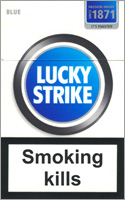 Lucky Strike cigarettes have always been just right there
Lucky Strike cigarettes have always been just right there
 History of Lucky Strike brand began in the XIX century. R.A. Patterson Company has registered some products for sale in the famous “tobacco” state of Virginia in 1871, but this was not the sale of cigarettes, they will be created a bit later.
History of Lucky Strike brand began in the XIX century. R.A. Patterson Company has registered some products for sale in the famous “tobacco” state of Virginia in 1871, but this was not the sale of cigarettes, they will be created a bit later.
Initially, there was produced and marketed compressed tobacco under the trademark “Lucky Strike” to population (that is exactly how the title Lucky Strike is translated). However, for a long time there was noticed nothing special about the brand and was just one of the many brands in the United States.
Everything changed in 1905 when American Tobacco Company decided to buy Lucky Strike. And not only just to buy, but also to earn money with the help of “Strike”. Marketers based their faith on the sonorous name, which fully complied with the spirit of the times, with the very essence of American dream. One successful investment could bring millions of dollars.
And the ability to catch the moment and make a bet on luck was valued higher than profound knowledge and practical experience. Consumers immediately paid attention to a new brand, but the real explosion followed afterwards.
The victorious march of Lucky Strike cigarettes started with the occurrence of advanced technology. In 1916, the brand began to produce cigarettes, and already in a year, wishing to get ahead of the competitors, applied a truly innovative method of tobacco preparation. If other sellers dried tobacco leaves under the rays of the sun, the Lucky Strike manufacturers went further and began to fry them.
Due to tosterization (that’s how this process was called), there took place a reaction of caramelization in leaves. Thanks to the latter, tobacco was not just getting more aromatic, but also got a chocolate and coffee taste.
War has always been the best time to promote such “light drugs” like alcohol and tobacco. So when World War II began in Europe, and American soldiers went overseas, Lucky Strike cigarettes were just right there.
The cigarettes with the inscription “It’s Toasted” quickly began to push competitors back. Many tobacco manufacturers immediately began experimenting with drying regimes. Hence, it was necessary to look for new ways to promote goods to higher levels.
To stand out among other brands, manufacturers changed the design even of the package. There was introduced a red-and-white package instead of the green range. In order to clarify such a sudden rebranding, there was immediately added a patriotic explanation.
